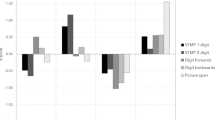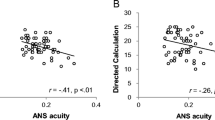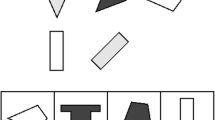Abstract
Individuals scoring higher in tests of general cognitive abilities tend to perform better on novel and familiar mathematical tasks. It has been scarcely investigated how this superior mathematical performance relates to the amount of cognitive resources that is invested to solve a given task. In this study we propose that, on novel tasks, individuals with high cognitive abilities outperform less able individuals, because they allocate a higher amount of resources. On familiar tasks, however, individuals with higher abilities profit from more efficient processes compared to individuals of lower cognitive abilities. We tested this hypothesis by administering to 11th graders a geometric analogy task not practiced at school and an algebraic transformation task comprising operations that are routinely required during mathematical courses. General cognitive abilities were measured with Ravens Advanced Progressive matrices (fluid intelligence), the d2 (focused attention) and KAI-N (working memory capacity). Resource allocation was measured by assessing pupil diameter during the problem-solving process. Performance on both the analogy and the algebra task was correlated with general cognitive abilities, especially fluid intelligence. In line with our assumptions, a positive correlation between fluid intelligence and resource allocation was observed in the novel geometric analogy task, whereas the correlation was not significant in the more familiar algebra task.



Similar content being viewed by others
Notes
This uneven gender ratio in our sample roughly reflects the gender ratio in these schools.
Replaced data in choice reaction time task 4.9% (SD 9.7); analogy task 5.8% (SD 8.7); algebra task 5.3% (SD 9.1).
This was done to allow for the redilation of the pupil. As the pupil responds with a certain delay to cognitive work (cf. Loewenfeld 1993), processes active during solving the task might be visible in pupillary response shortly after the trial ends.
References
Ackerman, P. L., & Heggestad, E. D. (1997). Intelligence, personality, and interests: Evidence for overlapping traits. Psychological Bulletin, 121(2), 219–245.
Ahern, S., & Beatty, J. (1979). Pupillary responses during information processing vary with Scholastic Aptitude Test scores. Science, 205(4412), 1289–1292.
Aston-Jones, G., & Cohen, J. D. (2005). An integrative theory of locus coeruleus–norepinephrine function: Adaptive gain and optimal performance. Annual Review of Neuroscience, 28, 403–450.
Aston-Jones, G., Rajkowski, J., Kubiak, P., & Alexinsky, T. (1994). Locus coeruleus neurons in monkey are selectively activated by attended cues in a vigilance task. Journal of Neuroscience, 14(7), 4467–4480.
Aunola, K., Leskinen, E., & Nurmi, J.-E. (2006). Developmental dynamics between mathematical performance, task motivation, and teachers’ goals during the transition to primary school. British Journal of Educational Psychology, 76(1), 21–40.
Baddeley, A. (1986). Working memory. Oxford: Oxford University Press.
Beatty, J., & Kahneman, D. (1966). Pupillary changes in two memory tasks. Psychonomic Science, 5(10), 371–372.
Blair, C. (2006). How similar are fluid cognition and general intelligence? A developmental neuroscience perspective on fluid cognition as an aspect of human cognitive ability. Behavioral Brain Science, 26, 109–160.
Bortz, J. (2005). Statistik für Human- und Sozialwissenschaftler (6th ed.). Heidelberg: Springer.
Brickenkamp, R. (1986). Handbuch apparativer Verfahren in der Psychologie. Göttingen: Hogrefe.
Brickenkamp, R. (2000). Test d2. Aufmerksamkeits-Belastungs-Test. Göttingen: Hogrefe.
Bull, R., & Johnston, R. S. (1997). Children’s arithmetical difficulties: Contributions from processing speed, item identification, and short-term memory. Journal of Experimental Child Psychology, 65, 1–24.
Cattell, R. B. (1987). Intelligence: Its structure, growth and action. North-Holland: Amsterdam.
Colom, R., Abad, F. J., Quirora, Á., Shih, P. C., & Flores-Mendoza, C. (2008). Working memory and intelligence are highly related constructs, but why? Intelligence, 36, 584–606.
Conway, A. R. A., Kane, M. J., & Engle, R. W. (2003). Working memory capacity and its relation to general intelligence. Trends in Cognitive Sciences, 7, 547–552.
Courant, R., & Robbins, H. (1996). What is mathematics? An elementary approach to ideas and methods. Oxford: Oxford University Press.
Dehaene, S., Piazza, M., Pinel, P., & Cohen, L. (2003). Three parietal circuits for number processing. Cognitive Neuropsychology, 20, 487–506.
Delazer, M., Domahs, F., Bartha, L., Brenneis, C., Lochy, A., Trieb, T., et al. (2003). Learning complex arithmetic—An fMRI study. Cognitive Brain Research, 18(1), 76–88.
Duncan, J. (2003). Intelligence tests predict brain response to demanding task events. Nature Neuroscience, 6(3), 207–208.
Ferrer, E., O’Hare, E. D., & Bunge, S. A. (2009). Fluid reasoning and the developing brain. Frontiers in Neuroscience, 3, 46–51.
Floyd, R. G., Evans, J. J., & McGrew, K. S. (2003). Relations between measures of Cattell–Horn–Carroll (CHC) cognitive abilities and mathematics achievement across the school years. Psychology in the schools, 40(2), 155–171.
Gehring, W. J., & Willoughby, A. R. (2002). The medial frontal cortex and the rapid processing of monetary gains and losses. Science, 295, 2279–2281.
Gilzenrat, M. S., Cohen, J. D., Rajkowski, J., & Aston-Jones, G. (2003). Pupil dynamics predict changes in task engagement mediated by locus coeruleus. Society of Neurosciences, Abstracts, Program No. 515.19.
Gilzenrat, M. S., Nieuwenhuis, S., Jepma, M., & Cohen, J. D. (2010). Pupil diameter tracks changes in control state predicted by the adaptive gain theory of locus coeruleus function. Cognitive, Affective, & Behavioral Neuroscience (in press).
Goswami, U. (1992). Analogical reasoning in children. Hillsdale, NJ: Lawrence Erlbaum.
Gottfredson, L. S. (1997). Why g matters: the complexity of everyday life. Intelligence, 24, 79–132.
Grabner, R. H., Ansari, D., Koschutnig, K., Reishofer, G., Ebner, F., & Neuper, C. (2009). To retrieve or to calculate? Left angular gyrus mediates the retrieval of arithmetic facts during problem solving. Neuropsychologia, 47, 604–608.
Grabner, R. H., Ansari, D., Reishofer, G., Stern, E., Ebner, F., & Neuper, C. (2007). Individual differences in mathematical competence predict parietal brain activation during mental calculation. Neuroimage, 38(2), 346–356.
Grabner, R. H., Stern, E., & Neubauer, A. C. (2003). When intelligence loses its impact: neural efficiency during reasoning in a familiar area. International Journal of Psychophysiology, 49, 89–98.
Granholm, E., & Steinhauer, S. R. (2004). Pupillometric measures of cognitive and emotional processes. International Journal of Psychophysiology, 52(1), 1–6.
Gray, J. R., Chabris, C. F., & Braver, T. S. (2003). Neural mechanisms of general fluid intelligence. Nature Neuroscience, 6(3), 316–322.
Hayes, J. R. (1973). On the function of visual imagery in elementary mathematics. In W. Chase (Ed.), Visual information processing (pp. 177–214). New York: Academic Press.
Heitz, R. P., Schrock, J. C., Payne, T. W., & Engle, R. W. (2008). Effects of incentive on working memory capacity: Behavioral and pupillometric data. Psychophysiology, 45(1), 119–129.
Heller, K. A., Kratzmeier, H., & Lengfelder, A. (1998). Matrices-test-manual volume 2. A manual with German norms for the standard progressive matrices of J.C. Raven.. Weinheim: Beltz-Test GmbH.
Hess, E. H., & Polt, J. M. (1964). Pupil size in relation to mental activity during simple problem-solving. Science, 143(3611), 1190–1192.
Ischebeck, A., Zamarian, L., Egger, K., Schocke, M., & Delazer, M. (2007). Imaging early practice effects in arithmetic. Neuroimage, 36, 993–1003.
Just, M. A., & Carpenter, P. A. (1992). A capacity theory of comprehension: Individual differences in working memory. Psychological Review, 99(1), 122–149.
Just, M. A., Carpenter, P. A., & Miyake, A. (2003). Neuroindices of cognitive workload: Neuroimaging, pupillometric and event-related potential studies of brain work. Theoretical Issues in Ergonomics Science, 4(1), 56–88.
Kahneman, D., & Beatty, J. (1967). Pupillary responses in a pitch-discrimination task. Perception & Psychophysics, 2(3), 101–105.
Kail, R., & Hall, L. K. (1999). Sources of developmental change in children’s word problem performance. Journal of Educational Psychology, 91, 660–668.
Lee, K. H., Choi, Y. Y., Gray, J. R., Cho, S. H., Chae, J.-H., Lee, S., et al. (2006). Neural correlates of superior intelligence: Stronger recruitment of posterior parietal cortex. Neuroimage, 29(2), 578–586.
LeFerve, J., DeStefano, D., Coleman, B., & Shanahan, T. (2005). Mathematical cognition and working memory. In J. I. D. Campbell (Ed.), Handbook of mathematical cognition. New York: Psychology Press.
Lehrl, S., & Blaha, L. (2004). Messung des Arbeitsgedächtnisses, KAI-N. Ebersberg: VLESS.
Loewenfeld, I. E. (1993). The pupil. Iowa State University Press: Ames.
McArdle, J. J., Ferrer-Caja, E., Hamagami, F., & Woodcock, R. W. (2002). Comparative longitudinal structural analysis of growth and decline of multiple intellectual abilities over the lifespan. Developmental Psychology, 38, 113–142.
Mogle, J. A., Lovett, B. J., Stawski, R. S., & Sliwinski, M. J. (2008). What’s so special about working memory? Psychological Science, 19(11), 1071–1077.
Moutafi, J., Furnham, A., & Crump, J. (2003). Demographic and personality predictors of intelligence: A study using the neo personality inventory and the Myers-Briggs type indicator. European Journal of Personality, 17(1), 79–94.
Neubauer, A. C., Grabner, R. H., Freudenthaler, H. H., Beckmann, J. F., & Guthke, J. (2004). Intelligence and individual differences in becoming neurally efficient. Acta Psycho. (Amst), 116(1), 55–74.
Nuthmann, A., & van der Meer, E. (2005). Time’s arrow and pupillary response. Psychophysiology, 42(3), 306–317.
Oberauer, K., Süß, H.-M., Wilhelm, O., & Wittmann, W. W. (2008). Which working memory functions predict intelligence. Intelligence, 36(6), 641–652.
O’Boyle, M. W., Cunnington, R., Silk, T. J., Vaughan, D., Jackson, G., Syngeniotis, A., et al. (2005). Mathematically gifted male adolescents activate a unique brain network during mental rotation. Cognitive Brain Research, 25(2), 583–587.
Offenhaus, B. (1983). Individual differences in analogical reasoning. Thesis. Berlin: Humboldt-University.
Olkin, J., & Siotani, M. (1964). Asymptotic distribution functions of a correlation matrix. Stanford, CA: Stanford Laboratory for Quantitative Research in Education. Report No 6.
Poldrack, R. A., Desmond, J. E., Glover, G. H., & Gabrieli, J. D. E. (1998). The neural basis of visual skill learning: An fMRI study of mirror reading. Cerebral Cortex, 8(1), 1–10.
Porter, G., Troscianko, T., & Gilchrist, I. D. (2007). Effort during visual search and counting: Insights from pupillometry. The Quarterly Journal of Experimental Psychology, 60(2), 211–229.
Raine, A., Reynolds, C., Venables, P. H., & Mednick, S. A. (2002). Stimulation seeking and intelligence: A prospective longitudinal study. Journal of Personality and Social Psychology, 82(4), 663–674.
Raisig, S., Welke, T., Hagendorf, H., & van der Meer, E. (2007). Investigating dimensional organization in scripts using the pupillary response. Psychophysiology, 44(6), 864–873.
Rajkowski, J., Kubiak, P., & Aston-Jones, G. (1993). Correlations between locus coeruleus (LC) neural activity, pupil diameter and behavior in monkey support a role of LC in attention. Society of Neurosciences, Abstracts, 19, 974.
Raven, J. C. (1958). Advanced progressive matrices. London: Lewis.
Royer, F. L. (1981). Detection of symmetry. Journal of Experimental Psychology: Human Perception and Performance, 7(6), 1186–1210.
Rypma, B., & Prabhakaran, V. (2009). When less is more and when more is more: the mediating roles of capacity and speed in brain-behavior efficiency. Intelligence, 37(2), 207–222.
Rypma, B., Berger, J. S., Prabhakaran, V., Bly, B. M., Kimberg, D. Y., Biswal, B. B., et al. (2006). Neural correlates of cognitive efficiency. Neuroimage, 33(3), 969–979.
Shaw, P., Greenstein, D., Lerch, J., Clasen, L., Lenroot, R., Gogtay, N., et al. (2006). Intellectual ability and cortical development in children and adolescents. Nature, 440, 676–679.
Van der Meer, E. (1996). Memory and analogical reasoning. In D. Herrmann, C. McEvoy, C. Hertzog, P. Hertel, & M. K. Johnson (Eds.), Basic and applied memory research: practical applications (pp. 139–151). Mahwah, NJ: Lawrence Erlbaum Associates.
Van der Meer, E., Beyer, R., Horn, J., Foth, M., Bornemann, B., Ries et al. (2010). Resource allocation and fluid intelligence: Insights from pupillometry. Psychophysiology, 47(1), 158–169.
Verney, S. P., Granholm, E., & Marshall, S. P. (2004). Pupillary responses on the visual backward masking task reflect general cognitive ability. International Journal of Psychophysiology, 52(1), 23–36.
Wager, T. D., Jonides, J., & Reading, S. (2004). Neuroimaging studies of shifting attention: a meta-analysis. Neuroimage, 22, 1679–1693.
Wagner, A. D., Maril, A., Bjork, R. A., & Schacter, D. L. (2001). Prefrontal Contributions to executive. Neuroimage, 14, 1337–1347.
Wartenburger, I., Heekeren, H. R., Preusse, F., Kramer, J., & van der Meer, E. (2009). Cerebral correlates of analogical processing and their modulation by training. Neuroimage, 48, 291–302.
Acknowledgments
This research was supported by grants from the German Federal Ministry for Education and Research (BMBF, Programme: Neuroscience-Instruction-Learning). IW was funded by the Stifterverband fuer die Deutsche Wissenschaft, Claussen-Simon-Stiftung.
Author information
Authors and Affiliations
Corresponding author
Rights and permissions
About this article
Cite this article
Bornemann, B., Foth, M., Horn, J. et al. Mathematical cognition: individual differences in resource allocation. ZDM Mathematics Education 42, 555–567 (2010). https://doi.org/10.1007/s11858-010-0253-x
Accepted:
Published:
Issue Date:
DOI: https://doi.org/10.1007/s11858-010-0253-x




